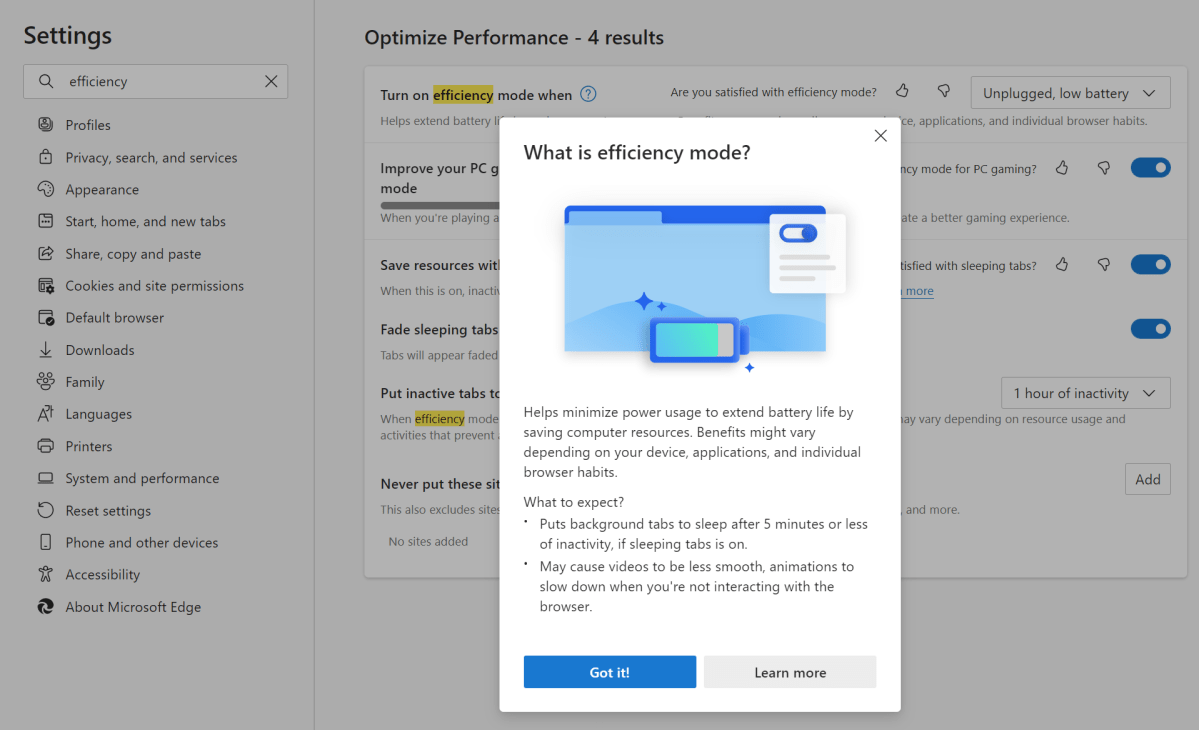 Image: Google
Image: Google
Google Chrome has long had a reputation of being fast, secure… and ravenous for memory like a starving teenager at an all-you-can-eat buffet. But finally, Chrome is going to slim down right in time for the new year.
Chrome version 110 introduced new Memory Saver and Battery Saver features on Windows, Macs and Chromebooks alike, after Google first teased the tools in December. They’re both on by default, as first noted by Android Police, though you can disable them completely.
The features work pretty much as advertised. Memory Saver is being pitched as a “smoother-running browser experience,” promising to save up to 30 percent more memory when running Chrome. How? By freeing up memory from tabs that you aren’t actively using. If a tab is idling, it will essentially be put into a static mode where its resources will be available elsewhere, then reloaded if needed (though you can also opt to whitelist a tab to prevent Memory Saver from kicking in if desired).
“This is especially useful if you’re running other intensive applications, like editing family videos or playing games,” Google said in a blog post announcing the new feature.

If this seems somewhat familiar, it should. Microsoft Edge already can put tabs to sleep to save resources. If you have dozens of tabs open in Edge, several probably won’t be in active use. You’ll see the tabbed icons along the top of the browser window visually faded out, to indicate their status. Hover over them, and Edge will tell you that the tab is sleeping, as well as how much memory that’s saving. In Chrome, Google plans to put controls for this feature in the “ellipsis” menu to the upper right, though it will be on by default. (Why turn it off? If you have a frequently-updated tab like Twitter, you might want to keep it active.)
Energy Saver acts in a similar manner. If your laptop’s battery level drops to 20 percent, Google Chrome will enter Energy Saver mode and start conserving power: limiting background activity and visual effects for those sites which use them.

Mark Hachman / IDG
Mark Hachman / IDG
Mark Hachman / IDG
Likewise, Microsoft was first to announce a similar battery-saving mode, which it announced in October in conjunction with Edge 106. (The current version at press time is version 107.) Edge’s “efficiency mode” is a bit more sophisticated: it offers various tradeoffs to preserve battery life in various states, such as being unplugged as well as in a low-power state. For example, when your device is unplugged and low on battery, it will have a visual impact on your browsing experience, making videos less smooth, for example. You can enter the Edge Settings menu to adjust it, if you wish.
Both Edge and Chrome are built on Chromium, though, so it seems natural that they’d share some features. Whichever browser you choose, though, you’ll benefit.
Editor’s note: This article first published with information about the new features on December 9, 2022, but was updated when Chrome 110 introduced the new tools.
Author: Mark Hachman, Senior Editor

As PCWorld’s senior editor, Mark focuses on Microsoft news and chip technology, among other beats. He has formerly written for PCMag, BYTE, Slashdot, eWEEK, and ReadWrite.
Recent stories by Mark Hachman:
Udio’s AI music is my new obsessionBroadband ‘nutrition labels’ kick in, revealing hidden fees for ISPsHappy 20th birthday to Gmail, the email client that changed our lives



